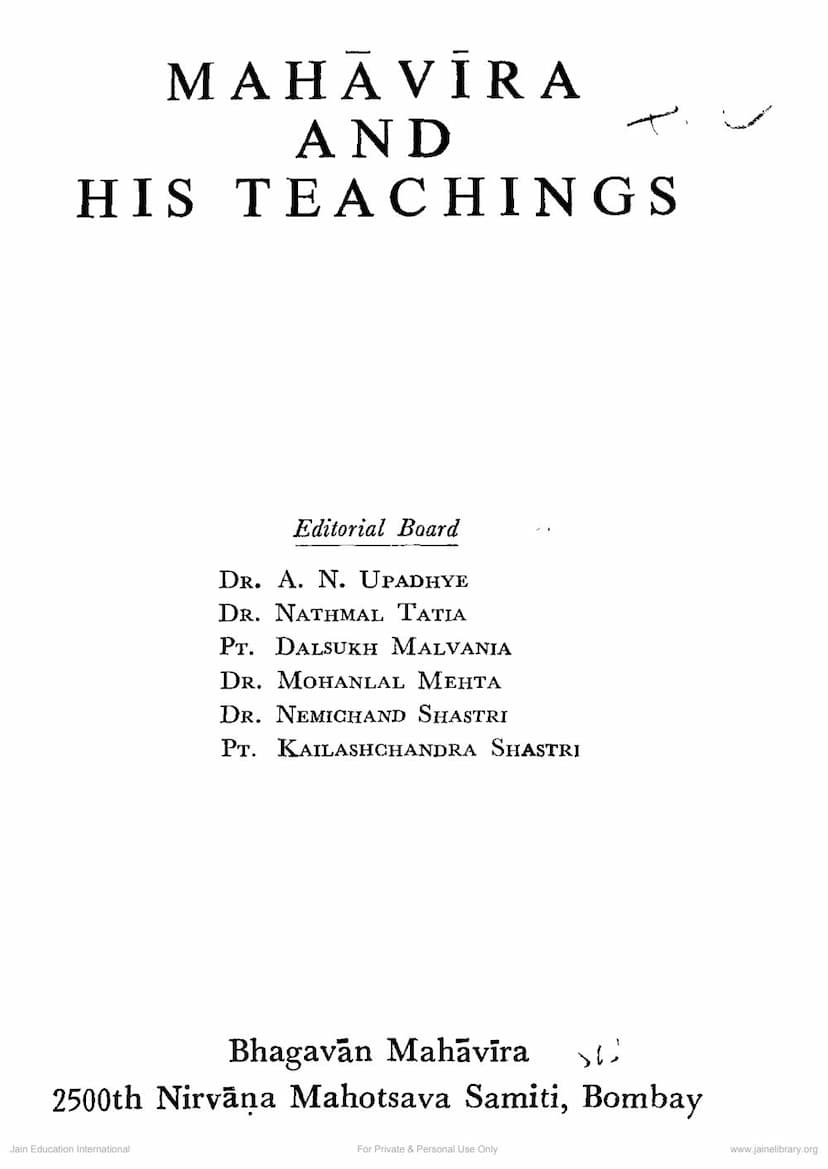Mahavira And His Teaching
Added to library: September 2, 2025

Summary
Here is a comprehensive summary of the Jain text "Mahavira and his Teachings," based on the provided pages:
Mahāvīra and His Teachings: A Commemorative Volume
This book, published by the Bhagavān Mahāvīra 2500th Nirvāṇa Mahotsava Samiti in Bombay in 1977, serves as a collection of scholarly articles celebrating the 2500th Nirvana anniversary of Lord Mahāvīra, the 24th Tirthankara of Jainism. The volume aims to perpetuate the memory of this significant event through literature of abiding value. It includes articles focusing on Mahāvīra and his teachings, alongside related topics in Jainism.
Core Tenets and Mahāvīra's Philosophy:
The editorial note highlights Mahāvīra as a champion of human dignity and freedom. It emphasizes his proclamation of equal rights to all living beings, with non-violence (Ahimsa) as a foundational vow. Mahāvīra's teachings stress the rejection of possessions and attachment as crucial for achieving liberation. In a world increasingly marked by greed and violence, the volume suggests a return to the wisdom of ancient preachers like Mahāvīra and Buddha for finding paths to liberation, freedom, and peace.
Content and Structure of the Book:
The book is structured into several thematic sections, each containing articles by various scholars:
-
I. Literature: This section delves into Jaina exegetical literature and the history of the Jaina canon, exploring topics like:
- Jaina exegetical literature and the history of the Jaina canon (L. Alsdorf).
- A metrical analysis of a chapter of the Uttarādhyayana-sūtra (K. R. Norman).
- The Bārasa-Anuvekkha of Kundakunda (Chandrabhal Tripathi and Bansidhar Bhatt).
- Jīvakacintāmaṇi as a channel for Mahāvīra's teachings (Dr. Miss V. Muthuccumaru).
- Analysis of non-canonical Subhāṣita collections in Jaina literature (Ludwik Sternbach).
- Variant forms of the locative in Middle Indo-Aryan (L. A. Schwarzschild).
- Towards a lexicon of Old Gujarati (Ernest Bender).
-
II. Religion: This section explores various religious and philosophical aspects of Jainism:
- Bhavyatva and Abhavyatva: A Jain doctrine of 'predestination' (Padmanabh S. Jaini).
- Fasting unto death according to Āyāranga-sutta and some Païņṇayas (Colette Caillat).
- Jaina mysticism (Kamal Chand Sogani).
- The relevance of Jaina ethics in the present age (Shashi Bhushan Prasad Sinha).
- Jainism and influences from Western social reformers in Gandhiji's Weltanschauung (Dr. Heimo Rau).
- Hindu and Jaina concepts of Mahapralaya versus Modern Science (Prof. G. R. Jain).
- How it works: An explanation of the Jaina metaphysical system (S. Gajapathi).
-
III. Mahāvīra: This section is dedicated to Lord Mahāvīra himself:
- A poem, "In Jainism, O Rejoice" (Leona Smith Kremser).
- Mahāvīra, the Great Propounder of Jainism (A. L. Basham).
- Lord Mahāvīra and the Anyatirthikas (J. Deleu).
- The Age of Mahāvīra (Adris Banerji).
- "Thus Spake Mahāvīra" (A. S. Gopani).
- Vardhamana Mahāvīra (K. R. Chandra).
- Lord Mahāvīra and his Teachings (K. M. Patel).
- A poem, "Lord Mahāvīra" (K. M. Patel).
-
V. Philosophy: This section covers Jaina philosophical concepts:
- The Jaina logic of Seven-fold Predication (R. N. Mukerji).
- Consideration of Self in Jaina Philosophy (B. J. Jhaveri).
- Concept of Substance in Jainism (Bashistha Narayan Sinha).
- Niyativāda (Pre-destination, Fatalism, Determinism): A Study (V. M. Kulkarni).
-
VI. Art: This section focuses on Jaina art and iconography:
- Accounts of the Jainas taken from Sixteenth and Seventeenth Century Authors (R. Williams).
- The Genesis of the Digambara-Śvetāmbara Split (Buddha Prakash).
- Patronage to Jainism by the Śilāhāras of Kolhapur (V. V. Mirashi).
- The Ascendency and Eclipse of Bhagavān Mahāvīra's Cult in the Tamil Land (K. A. Nilakanta Šāstri and V. Rāmasubramaniam 'Aundy').
- Agasthya and Antiquity of Jainism in Tamilnad (V. G. Nair).
- Further Observations on the Iconography of Pārsvanātha (Klaus Bruhn).
- Earliest Jaina Inscription from Maharashtra (H. D. Sankalia).
- Jaina Metal Images in the State Museum, Lucknow (N. P. Joshi).
- Jina Images in the Archaeological Museum, Khajuraho (Maruti Nandan Prasad Tiwari).
- Mahāvīra Icon and Indian Archaeology (B. Upadhyay).
- Farther-Eye in the East Indian and Nepalese Painting (Anand Krishna).
- Is Jainism an Opponent of Hinduism? (D. N. Shukla).
Key Themes and Contributions:
The collection presents a broad spectrum of Jaina thought, covering its philosophical underpinnings, historical development, and artistic expressions. Several articles highlight Mahāvīra's emphasis on ethical conduct, non-violence, and personal liberation through self-effort. The book also explores the historical interactions between Jainism and other religious traditions, as well as its influence on prominent figures like Mahatma Gandhi. The various articles collectively aim to provide a comprehensive understanding of Mahāvīra's teachings and their enduring relevance.